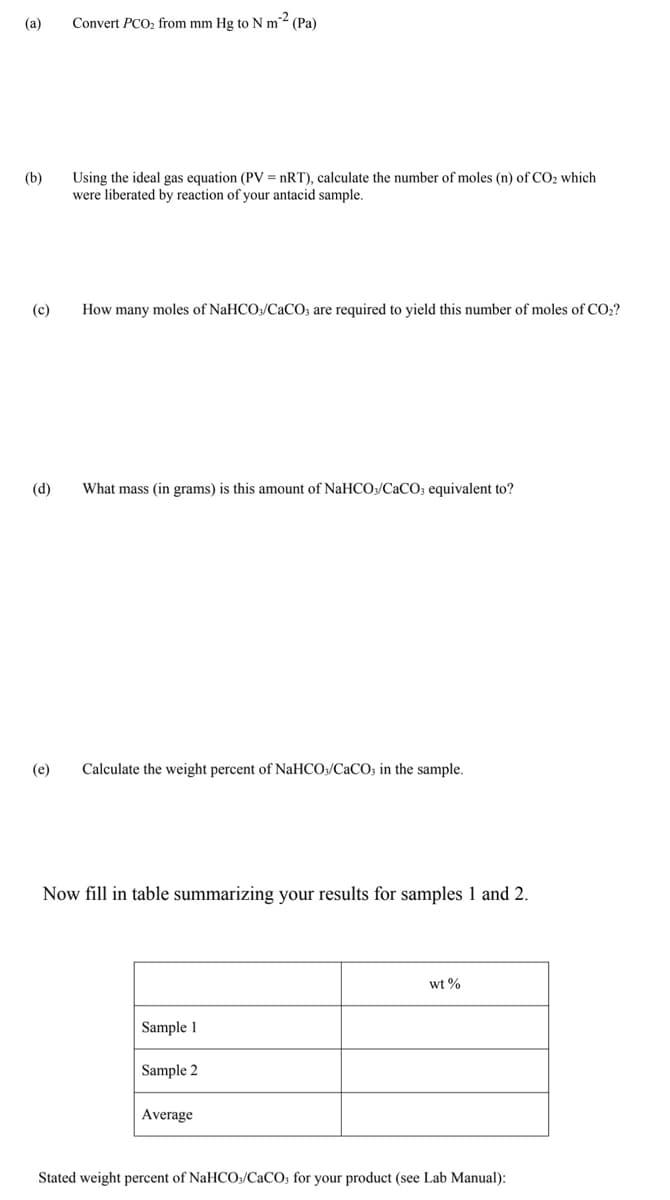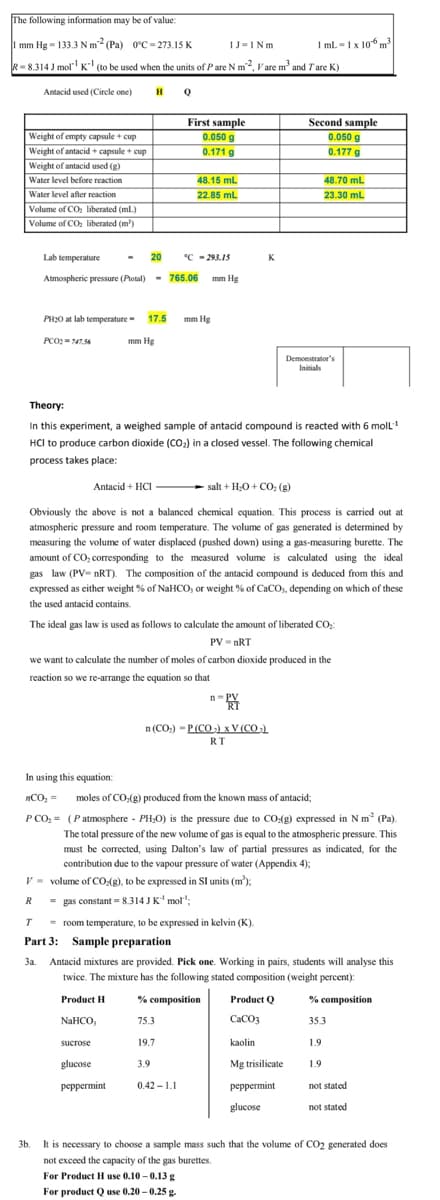Convert PCO: from mm Hg to N m (Pa) Using the ideal gas equation (PV = nRT), calculate the number of moles (n) of CO2 which were liberated by reaction of your antacid sample. (b) (c) How many moles of NaHCO/CaCO, are required to yield this number of moles of CO2?
Convert PCO: from mm Hg to N m (Pa) Using the ideal gas equation (PV = nRT), calculate the number of moles (n) of CO2 which were liberated by reaction of your antacid sample. (b) (c) How many moles of NaHCO/CaCO, are required to yield this number of moles of CO2?
Chemistry: Principles and Reactions
8th Edition
ISBN:9781305079373
Author:William L. Masterton, Cecile N. Hurley
Publisher:William L. Masterton, Cecile N. Hurley
Chapter5: Gases
Section: Chapter Questions
Problem 35QAP: Nitric acid can be prepared by bubbling dinitrogen pentoxide into water....
Related questions
Question
100%
Please help me to complete the questions of pic 1, AND pic 2 is some relevant information. Need detailed calculation process and answers, thank you very much for your help!

Transcribed Image Text:(a)
Convert PCO2 from mm Hg to N m2 (Pa)
Using the ideal gas equation (PV = nRT), calculate the number of moles (n) of CO2 which
were liberated by reaction of your antacid sample.
(b)
(c)
How many moles of NaHCO:/CACO; are required to yield this number of moles of C02?
(d)
What mass (in grams) is this amount of NaHCO:/CaCO; equivalent to?
(e)
Calculate the weight percent of NaHCO3/CaCO; in the sample.
Now fill in table summarizing your results for samples 1 and 2.
wt %
Sample 1
Sample 2
Average
Stated weight percent of NaHCO3/CaCO; for your product (see Lab Manual):

Transcribed Image Text:The following information may be of value:
1 mm Hg - 133.3 Nm (Pa) 0°C = 273.15 K.
I ml -1x 10 m
1J=1Nm
R-8.314 J mol" K (to be used when the units of Pare N m, Vare m' and Tare K)
Antacid used (Circle one)
First sample
0.050 g
Second sample
Weight of empty capsule + cup
Weight of antacid + capsule + cup
0.050 g
0.171 g
0.177 g
Weight of antacid used (g)
Water level before reaction
48.15 mL
48.70 mL
Water level after reaction
22.85 mL
23.30 mL
Volume of CO liberated (ml.)
Volume of CO liberated (m')
Lab temperature
20
°C - 293.15
K
Atmospherie pressure (Potal) - 765.06
mm Hg
PH20 at lab temperature 17.5
mm Hg
PCO2=747.56
mm Hg
Demonstrator's
Initials
Theory:
In this experiment, a weighed sample of antacid compound is reacted with 6 molL
HCl to produce carbon dioxide (CO,) in a closed vessel. The following chemical
process takes place:
Antacid + HCI
salt + H;0+ CO: (g)
Obviously the above is not a balanced chemical equation. This process is carried out at
atmospheric pressure and room temperature. The volume of gas generated is determined by
measuring the volume of water displaced (pushed down) using a gas-measuring burette. The
amount of CO, corresponding to the measured volume is calculated using the ideal
gas law (PV- nRT). The composition of the antacid compound is deduced from this and
expressed as either weight % of NaHCO, or weight % of CACO, depending on which of these
the used antacid contains.
The ideal gas law is used as follows to calculate the amount of liberated CO
PV = nRT
we want to calculate the number of moles of carbon dioxide produced in the
reaction so we re-arrange the equation so that
n- PV
RT
n(CO.) - P(CO:) x V (CO.)
RT
In using this equation:
nCO, = moles of CO:(g) produced from the known mass of antacid;
P CO: = (Patmosphere - PH:0) is the pressure due to CO:(g) expressed in N m (Pa).
The total pressure of the new volume of gas is equal to the atmospheric pressure. This
must be corrected, using Dalton's law of partial pressures as indicated, for the
contribution due to the vapour pressure of water (Appendix 4);
V - volume of CO:(g), to be expressed in SI units (m');
= gas constant = 8.314 J K' mol
";
- room temperature, to be expressed in kelvin (K).
Part 3: Sample preparation
3a.
Antacid mixtures are provided. Pick one. Working in pairs, students will analyse this
twice. The mixture has the following stated composition (weight percent):
:
Product H
% composition
Product Q
% composition
NaHCO,
75.3
CaCO3
35.3
sucrose
19.7
kaolin
1.9
glucose
3.9
Mg trisilicate
1.9
реррermint
0.42 - 1.1
рерреrmint
not stated
glucose
not stated
3b.
It is necessary to choose a sample mass such that the volume of CO2 generated does
not exceed the capacity of the gas burettes.
For Product H use 0.10 -0.13 g
For product Q use 0.20 - 0.25 g.
Expert Solution
This question has been solved!
Explore an expertly crafted, step-by-step solution for a thorough understanding of key concepts.
Step by step
Solved in 5 steps

Knowledge Booster
Learn more about
Need a deep-dive on the concept behind this application? Look no further. Learn more about this topic, chemistry and related others by exploring similar questions and additional content below.Recommended textbooks for you

Chemistry: Principles and Reactions
Chemistry
ISBN:
9781305079373
Author:
William L. Masterton, Cecile N. Hurley
Publisher:
Cengage Learning

Chemistry for Engineering Students
Chemistry
ISBN:
9781337398909
Author:
Lawrence S. Brown, Tom Holme
Publisher:
Cengage Learning


Chemistry: Principles and Reactions
Chemistry
ISBN:
9781305079373
Author:
William L. Masterton, Cecile N. Hurley
Publisher:
Cengage Learning

Chemistry for Engineering Students
Chemistry
ISBN:
9781337398909
Author:
Lawrence S. Brown, Tom Holme
Publisher:
Cengage Learning


Chemistry: An Atoms First Approach
Chemistry
ISBN:
9781305079243
Author:
Steven S. Zumdahl, Susan A. Zumdahl
Publisher:
Cengage Learning

Chemistry
Chemistry
ISBN:
9781305957404
Author:
Steven S. Zumdahl, Susan A. Zumdahl, Donald J. DeCoste
Publisher:
Cengage Learning

Chemistry: The Molecular Science
Chemistry
ISBN:
9781285199047
Author:
John W. Moore, Conrad L. Stanitski
Publisher:
Cengage Learning